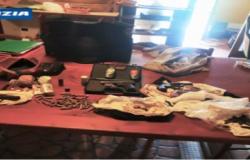The green transition? “The works for the electrification of both the Bersaglieri pier, therefore the cruise quay, and Pier VII, the container quay have already been awarded”
Trieste – The Bora doesn’t worry him so much, but the sudden changes in southerly winds and waves that bring storm surges, tear away the moorings from ships and require ever greater attention and commitment from all the technical nautical services. Luciano Del Prete, just turned 58, captain of vessel, maritime director of Friuli Venezia Giulia since 2022 and commander of the Port Authority of Trieste, born in Torre del Greco, “the city that provides the greatest number of ship commanders to the Italy”, speaks enthusiastically about Trieste. It talks about the many projects for the development of the port, the concerns about the effects of tensions in the Red Sea on traffic, the work for safety and also climate change which from theoretical analysis has become a concrete problem with emergencies to be managed in increasingly shorter times. quick.
Your experience in Trieste?
“I’ve been here for a year and a half, it’s an exciting experience full of new experiences. I know the port of Naples, but Trieste is a different port, which gives the possibility of knowing different types of traffic that develop, and they are two different ways of experiencing port life. I have excellent relations with the president of the Port System Authority of the Eastern Adriatic Sea, with whom we are able to work in symbiosis and in an effective and efficient manner, and with all the other administrations that operate in the port sector”.
In this regard, Zeno D’Agostino will leave as of June 1st. What will happen?
“A commissioner will certainly be appointed with whom we hope to continue, because there are many projects that are about to be put on the ground, are financed, and therefore there is a need for continuity. We as maritime management do and will continue to do our part. We expect that the commissioner who will be appointed will continue along the line traced by President D’Agostino and be able to put the projects on the ground.”
Let’s go back to the characteristics of Trieste, where port and city are the same thing.
“The people of Trieste experience the sea and the port as their own seafront also for recreational sports activities such as SUP or rowing. Sometimes I have to remind them that this is a port area and last year I had to issue an order forbidding the carrying out of activities with the SUP in the port area and the obligation of assistance of a motorboat for those who train in a canoe . Many times we found ourselves maneuvering large ships and finding ourselves next to people on SUPs or canoes with little nautical experience. And then there is the historic bathing establishment which is in the port, a particular and nice reality that I found in Trieste. We must balance the safety needs of port traffic with swimmers and athletes.”
Let’s talk about freight traffic in the port of Trieste. How is it going?
“Trieste is the leading port in Italy in terms of quantity of goods transported, in the order of 60 million tonnes per year. It is true that the majority of the tonnage comes from the transalpine oil pipeline, which supplies the refineries of Germany, Bavaria, Austria, the Czech Republic, with approximately 38-40 million tonnes of crude product per year, but also the handling of containers it is very respectable, just under a million teu. And cruise traffic has consolidated: we are in the order of 150 ships per year”.
Is the Suez crisis affecting trade? Is transshipment decreasing?
“There has been a decline in container traffic. In the first four months of the year compared to the same period last year we fell by 20%. About 10-15 fewer ships and the number of containers is lower. This means that non-transoceanic ships are arriving, and this worries us a little. There is a decline in ships over 300 metres. Last year we brought a 400 meter long ship, the MSC Nicola Mastro, into port: it was a test to verify the ability of the cranes to operate, the seabed and the moorings, but the future is projected to receive ships of this type . The fact that fewer are arriving is worrying.”
Oil traffic?
“We have an increase in tankers. From my office today I see 4 at anchor and 2 operating. Oil traffic has grown by 20% and we have a significant increase in berths. Therefore, in balancing, the overall tonnage of goods transported remains unchanged in the first quarter because there is a lot of oil, but the decline in containers remains worrying, also because there are many port development projects, especially for the yards and quays of the container terminals”.
The ferries? In addition to Türkiye there are also lines with Egypt and Morocco?
“On the ro-ro cargo line that arrives from Turkey we have several weekly docks, trucks and goods that are loaded mainly by train and are shipped to the heart of Europe. Because one of the characteristics of the port of Trieste – together with the fact that it is the first Italian port for rail traffic, over 50% of container traffic is moved by rail – is that both oil and goods arriving with containers and ferries are shipped in the heart of Europe. For now, no ships have arrived on the lines with Egypt and Morocco, it is ongoing traffic, but commercial agreements have been closed. The president of the ADSP immediately worked to remedy the decline in container traffic by procuring traffic from Damietta rather than from Morocco”.
The ecological transition?
“The works for the electrification of both the Bersaglieri pier, therefore the cruise quay, and Pier VII, the container quay, have already been awarded. We are very attentive to environmental issues. There is a need for emissions from cruise ships to be reduced because, as in Naples, they nose directly into the city, an advantage for the passenger, but the downside is that a ship emits fumes. For this reason, while waiting for the cold ironing, we have drawn up a protocol with the shipping companies, from cruises to ro-ros, which call at the port of Trieste, for the use of fuels with a low sulfur content already upon entry into the territorial waters in so that emissions are reduced to a minimum.”
The most important projects?
“There is the doubling of Pier VII, which will involve the replacement of the cranes and everything necessary for handling the containers. And then there is the construction of Pier VIII, a new terminal which will be built as an extension of the logistics platform, where the Servola ironworks once stood, and will be dedicated to container traffic with the creation of a mass field station for the harmonization of railway traffic . Then there is the Porto Vivo project, which involves the area of the old port, abandoned for decades, which will now be converted into a cruise hub. The cruise ships will be transferred to the docks and conference centers and areas and tourist recreational facilities will be built on land.”
Are climate changes affecting the port?
“You get used to the Bora, characteristic of this city. What is happening in recent times and which is of most concern are the sudden and violent changes in weather. Between November and December, two major storms arrived, not from Bora but from winds coming from the southern quadrants which practically destroyed the Barcola seafront. Last year too, in the month of July, wind storms arrived with peak wind speeds of 90-100-110 per hour, it also happened the other day, so violent that even ships broke their moorings”.
How do you equip yourself to avoid damage?
“It’s a topic that requires attention. We asked the company of concessionaires of towing services, by virtue of climate change but also of naval gigantism, to include more powerful tugboats with greater maneuverability in the fleet modernization plan. With these sudden changes in weather there is a need to have nautical technical services that are increasingly ready to deal with them. A few months ago a passenger ferry broke its moorings and the door ended up at 90 degrees on the dock. The day before yesterday we had to use tugboats to push the ships because they broke the mooring cables.”
Can something be done from an infrastructural point of view?
“Unfortunately not, because the docks here were designed by the Austrians to be oriented along the edge of the Bora. So from the Bora, with which we have learned to live, we are protected, but when the winds arrive from the southern quadrants the seafront and some moorings are exposed”.
The role of the Captaincy?
“We work on safety, understood as both safety and security. We have 18 terminals in the port and all activities in this area are carried out by our men but we work together with the other administrations, the technical nautical sectors and our ADSP colleagues. And the same goes for coast guard activities, security checks and recreational navigation. Let’s not forget that Friuli is the region that offers the greatest number of berths per linear kilometer and this means that there are more boats at sea during the summer season”.
Does being in a border region entail particular commitments?
“The average Trieste boater is inclined to go towards Slovenia and Croatia, so we often carry out rescue activities coordinated with our Slovenian and Croatian colleagues. We have drawn up several memoranda of understanding and agreements, the last one closed a few months ago: it is a project financed by the European Community on anti-pollution activities at sea. It is called Namirs, North Adriatic Maritime Incident Response System and provides shared standard operating procedures to be able to intervene in the event of an accident at sea and related oil spill. Pollution at sea knows no borders, we must cooperate.”






